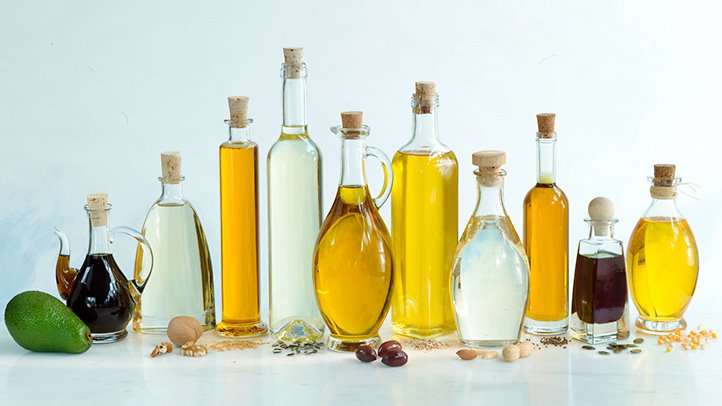Your cart is currently empty!
The Right Oil for Every Dish

The sheer number of options in the grocery store cooking oil aisle can be overwhelming, leaving you wondering, “Which one should I choose?” But don’t worry, you’re not alone in this; picking the right oil doesn’t have to be difficult; it can be an exciting journey of discovery! Let’s explore the A-Z of grocery oils and discover how to match them with your cooking needs.
Why Is the Correct Oil Important?
Cooking oils are more than just a means of frying or greasing a pan; they are an essential component of flavor, texture, and nutrition in your food. While the wrong oil can overpower a dish or even degrade under high heat, releasing harmful compounds, the right oil can enhance it. The golden rule is that each oil has a flavor profile and a smoke point, which determines how and when to use it.
Recognizing Cooking Oils
The fundamentals should be understood before delving into which oil works best for which dish:
Smoke Point: All oils have a temperature at which they begin to deteriorate and smoke. Unhealthy chemicals and burned flavors can result from cooking at or above this threshold. Extra virgin olive oil, for instance, has a lower smoke point than avocado oil, making the latter more suitable for cooking at high temperatures.
Flavor Profile: Canola and grapeseed oils are neutral, whereas sesame and coconut oils have strong, unique flavors.
Nutritional Value: Certain oils are rich in omega-3 fatty acids (like flaxseed oil), while others provide essential vitamins like E and K. Your choice might also depend on dietary needs or health goals.
Cooking Oils for All Types of Cooking
To Cook at High Heat: Searing, Deep Frying, and Stir-Fries
- Avocado Oil: This oil has one of the highest smoke points, making it ideal for frying vegetables or scorching meats. Its taste is neutral, so it won’t overshadow your food.
- Peanut Oil: Due to its mild nutty flavour and high smoke point, peanut oil, which is frequently used in Asian cooking, is perfect for deep frying.
- Refined sunflower oil is an inexpensive, flavourless, and reasonably high smoke point deep-frying oil.
Cakes, muffins, and cookies for baking: Vegetable oil
- Soybean or canola oil:
It is a traditional option for baked items because of its light texture and neutral flavor. Without changing the flavor, it guarantees a moist crumb. - Coconut Oil: This oil is excellent for adding a trace of coconut scent and a natural sweetness to cakes or cookies. Melt it for smoother batters or use it firm for flaky pastries.
Extra Virgin Olive Oil (EVOO) for salads, dressings, and dips! A mainstay of Mediterranean cooking, extra virgin olive oil (EVOO) gives richness and depth to dips, vinaigrettes, and even when drizzled over fresh vegetables.
To get the greatest flavor, go for cold-pressed kinds.
- Walnut Oil: Chocolate mousse and other desserts, as well as green salads and cheeses, go well with walnut oil’s nutty flavor. Keep it from being heated because heat ruins its flavor.
Rich in omega-3 fatty acids, flaxseed oil works best when used cold in smoothies or sauces. Healthy recipes benefit greatly from its mildly nutty flavor. - Flaxseed Oil: Rich in omega-3s, this oil is best used cold for dressings or smoothies. Its slightly nutty flavor works well in wellness-focused recipes.
Roasting and Grilling
- Grapeseed oil: The oil for roasting herbs and vegetables while grilling meat because it has a fairly high smoke point and has a mild flavor.
- Sesame Oil: To finish grilling, drizzle some toasted sesame oil over the surface of meat or vegetables, adding an Asian-esque spin from its nutty, swirling smokes.
Optimal for Everyday Cooking and Stir-Fry
- Light Olive Oil: Light olive oil has been filtered and has a higher smoke point than extra virgin olive oil (EVOO), making the oil great for everyday cooking without dominating the food.
- Rice Bran Oil: An oil of great suitability for making curries or sautéing vegetables due to its mild flavor and its nutrient profile that is rather well-balanced.
Specialty Dishes
- Truffle Oil: Not used for cooking, but very good for adding a few drops on top of the pasta, risotto, or mashed potatoes-it would carry a heavy, low fry smell of earth within its luxurious aroma.
- Mustard Oil: mustard Oil is used in Indian and Bengali cooking, and it can really put a punch in the pickle, curry, and stir-fried dishes.
A few holding tips for cooking oils
- Keep it cool and dark: Oils spoiled by heat, light, and air can be stored in deep, dark stores. Oils-for example flaxseed or walnut-and acid oils benefit from refrigeration.
- Some oils, such as the refined oils, are much above-the-shelf life of unrefined oils or from-the specialty family, which could go rancid earlier. Check the expiration date and use them promptly.
Experiment and Have Fun!
Cooking is as much science as it is an art. It is critical to know the basics, but it is equally important to experiment sometimes. Sometimes you just have to add that last drizzle of sesame oil or splash on a bit of EVOO and it can turn a fairly boring dish into something magical.
Not only will you be improving the taste of your dishes but also your cooking experience with such oils. Next time you deal with that oil bottle, you will know exactly where to theorize how to illuminate that meal!
https://grocerybyguptas.com/instant-food-oats-maggi-kellogs/



Leave a Reply